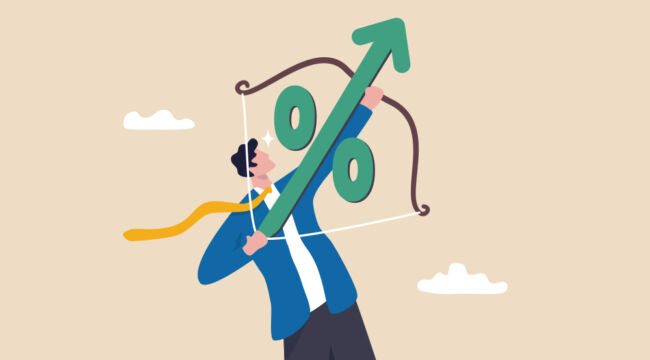Just How High Are Interest Rates?
Reports CNBC:
Inflation cooled in March as the Federal Reserve’s interest rate increases showed more impact, the Labor Department reported Wednesday.
The consumer price index, a widely followed measure of the costs for goods and services in the U.S. economy, rose 0.1% for the month against a Dow Jones estimate for 0.2%, and 5% from a year ago versus the estimate of 5.1%.
Just so. Yet we would remind you that 5% inflation — annualized — is nonetheless handsome. It remains an authentic phenomenon .
The Federal Reserve’s own inflationary gold standard is 2%. Meantime, the federal funds rate presently dangles between 4.75%–5%.
Thus the official inflation rate and the federal funds rate float in a general equilibrium.
The 10-year Treasury note presently yields 3.44% — inflation jogs ahead of it.
Yet what about the “real” inflation rate?
The “real” interest rate is defined as the nominal interest rate minus the inflation rate.
Assume a nominal interest rate of 3%, for example.
Further assume that inflation runs to 1%.
In this instance we find the real rate is 2% (3 – 1 = 2).
Now consider the case before us…
We employ as our ruler the 10-year Treasury yield rather than the federal funds rate. It is the bellwether rate.
To discover today’s real interest rate, we once again subtract the inflation rate from the nominal rate.
What do we find?
We find that today’s real interest rate is not 3.44% — but rather negative 1.56% (3.44%-5% = 1.56%).
That is, the real rate gutters substantially beneath the nominal rate.
We must then conclude that nominal interest rates lack all meaning absent the inflation rate.
There is a reason why it is called the real interest rate.
It penetrates numerical mists. It scatters statistical fogs.
It clarifies.
As explains Jim Rickards:
Real rates are what determine investment decisions. If you’re an economist or analyst trying to forecast markets based on the impact of rates on the economy, then you need to focus on real rates.
A 10-year Treasury bond yielding 7% might reel you in, for example.
But what if inflation averaged 8% over the bond’s duration?
Inflation would gobble your 7% yield — and a bit more into the bargain.
You would require a 9% yield to merely paddle ahead of inflation.
Meantime, you may balk at a 10-year Treasury bond yielding 3%.
But if inflation runs at 2%… then your 3% Treasury yields you 1%.
A slender gain, yes. Yet it is a gain. You escape with your skin — plus a slight amount of fat.
Your 3% Treasury… under these terms… infinitely bests a 7% Treasury if inflation runs to 8%.
Today’s 3.44% yields tower majestically over the 2020 yields that neared 0.50%.
Yet in real terms — in real terms — 2020 yields were greater because inflation had no existence.
What about gold? How does gold rate in a negative real rate panorama? Jim Rickards:
That’s an ideal environment for gold.
When one thinks of gold as a monetary asset (as I do), then the price analysis quickly moves to competing forms of money.
Gold has no yield. It’s not supposed to because it’s the purest form of money: a kind always accepted and always in demand, but not issued by a bank or broker. A dollar bill doesn’t offer any yield either. When other forms of money have high real yields, gold struggles except to the extent it is held as a precautionary or safe-haven asset.
But when other forms of money have… negative real yields (as is the case today), gold shines. And gold can perform even better when the safe-haven aspect is contemporaneous with a high-inflation period that results in negative real yields… A zero yield on gold is actually greater than the negative real yield on notes.
We note that gold has trampolined $218 since early March — incidentally. It presently trades at $2,030 the ounce.
Yet in August 2020 gold went at $2,069 the ounce. It has pedaled $39 backwards in three years.
This, despite delirious inflation rates unseen since the 1970s and severe geopolitical heats, most noticeably in Ukraine.
Why hasn’t gold gone skyshooting? Has gold lost its Midas touch?



Comments: